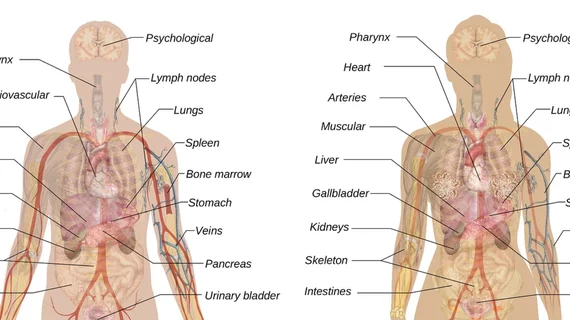Macrothrombi should raise concern for COVID-19
COVID-19 may present with medium to large arterial and venous macrothrombi of the abdomen and extremities, so radiologists should raise concern for it when identifying thromboembolic abdominopelvic findings.
New York University researchers assert as much in a study published online Thursday in the American Journal of Roentgenology.
Bari Dane, MD, and colleagues sought to explore arterial and venous thromboembolism in the abdomen, pelvis and lower extremities of patients with coronavirus disease. In retrospective reviews, they compared MRI or abdominal ultrasound studies performed on 82 subjects who had been diagnosed with COVID-19 with studies from 82 patients who did not have the virus.
All studies were evaluated for arterial or venous thromboembolism, the presence of which, when identified, was confirmed by two abdominal radiologists. Patients’ EMRs were reviewed for inflammatory markers, hospital course and, in those with thromboembolic findings, other hypercoagulability risk factors.
Thromboembolic findings were discovered in nine patients (11%) with COVID-19; of these patients, five had medium to large arterial thrombi. Additionally, CT revealed known portal vein thrombus on one patient without COVID-19.
Thromboembolic findings were found to occur more frequently in patients with the virus than in patients who had not been diagnosed with the disease (p = 0.02). The researchers used a Fisher exact test to compare the number of patients with COVID-19 who had thromboembolic findings to the number of COVID-19 patients who did not have these findings.
In their discussion, Dane et al. acknowledge among their design limitations a small sample and retrospective approach.
The authors also observe that the cohort “describes patients with ‘COVID’ in the radiology report and may not include all patients with COVID-19. Additionally, not all patients with thromboembolism undergo confirmative imaging, and some may not experience symptoms. Consequently, the prevalence is likely larger than reported.”
Nonetheless, they conclude, “COVID-19 may present with medium to large arterial and venous abdominal and extremity macrothrombi,” creating a need for radiologists to raise concern for COVID-19 when identifying thromboembolic abdominopelvic findings during the current pandemic.
